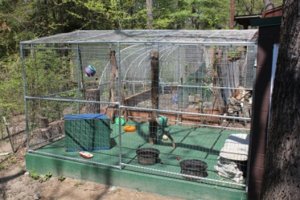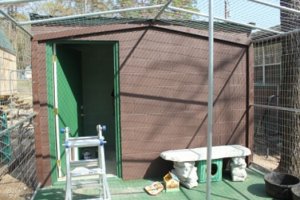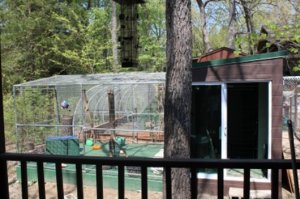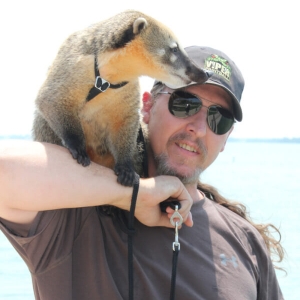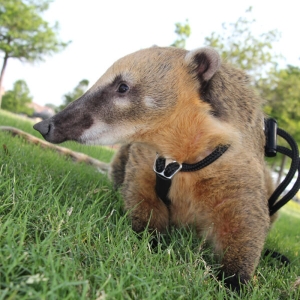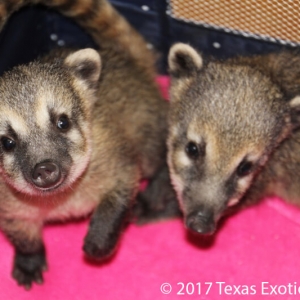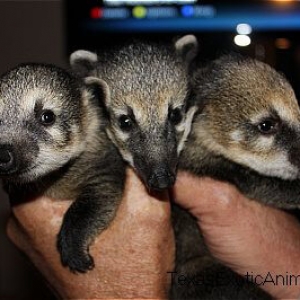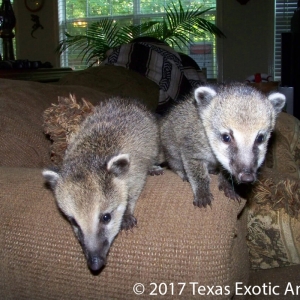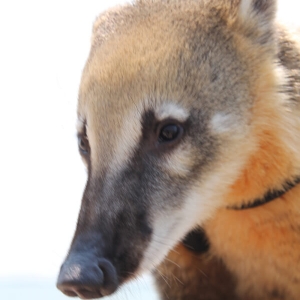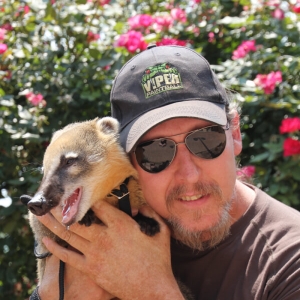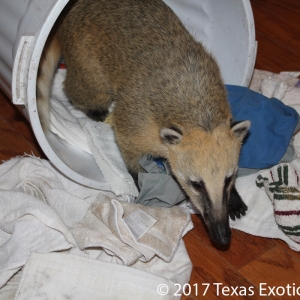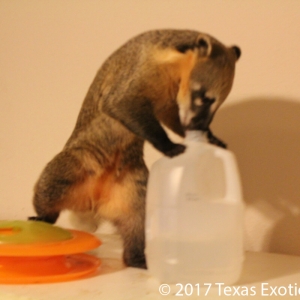MOUNTAIN COATI
/koʊˈɑdi/
noun: coati
plural noun: coatis
What is a Mountain Coati?
The mountain coati (also commonly referred to as coatimundi) is a Central or South American raccoon. Texas Exotic Animals breeds the Nasuellaolivacea, also referred to as the “mountain coati”, which is native to the Andes Mountains of South America. These delightful and curious little imps can be a handful, but are very interactive and enjoy lots of playtime. They are intelligent and active, and adapt well to their owner’s schedule. They are happiest with a large enclosure but, if this is not feasible, you can substitute lots of playtime outside their cage.
Mountain coati care is the same as the white-nosed coati, so on this page we will talk about the few differences. Please refer to our section on white-nosed coatis for diet and other basic cares suggestions.
Kingdom: Animalia
Phylum: Chordata
Class: Mammalia
Order: Carnivora
Family: Procyonidae
Genus: Nasua
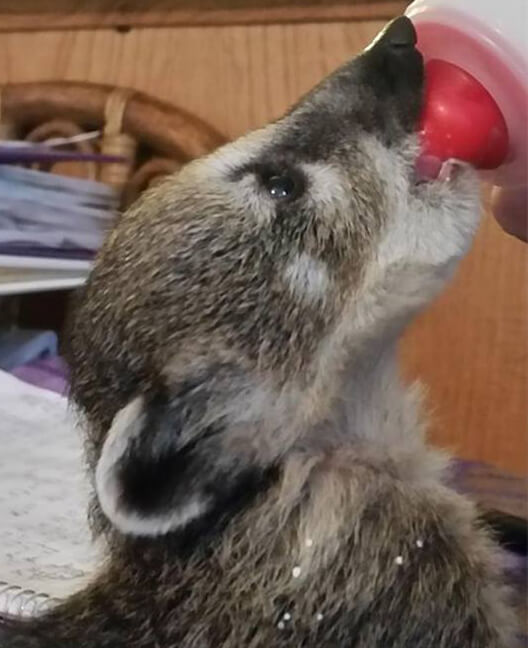
The mountain Coati is referred to by many different names. Some of them are ring-tailed Coati or blonde Coati. They most commonly referred to name is the mountain Coati although is it thought by some to be incorrect to call them that.
Color variations are many shades of tans, browns and greys. Some will be very blonde with ringed tails and some can be very dark faced with a ringed tail.
Mountain Coatis often have a slight musky smell that is more noticeable when they are in season. I don’t find it offensive or that noticeable. You might want to visit an adult Coati if you are highly sensitive to any kind of animal smell. Cat boxes and hamster cages smell much worse than anything Coati. Some say that mountain Coatis are smaller than white-nosed Coatis. In my opinion it might be true. However the difference in weight and size is very slight and not worth consideration when choosing a Coati.
The mountain Coati is commonly found and bred more often by Coati breeders and for that reason we have fewer mountain Coatis. I have found no difference in pet quality. Honestly, the main difference for a pet owner is which Coati’s appearance and coloration they like better.
Interested in purchasing a Mountain Coati?
Please fill out our availability form and we will contact you directly.
Common questions about Coatis
Staple Diet: A healthy dry dog food. Never cat food. I have been feeding Iams lamb and rice. My vet recommends the Iams lamb and rice too. Free feed unless your coati has a weight problem. If you feel your coati is becoming overweight consult your vet for a proper diet.
Additional foods: In moderation you can feed them almost anything you can eat. Healthier choices are eggs, fruits (No fruit cores. Apple, orange, and pear seeds are toxic. I remove all hard seeds), veggies (mine like carrots, sweet potatoes and collard greens), nuts, healthy dry cereals, Mazuri Monkey Crunch biscuits, cooked chicken meat (no chicken bones unless you want to chance a vet visit as they can splinter) fish, shrimp, and frozen thawed feeder mice, pinkies, and small rats. They can eat larger prey items like adult rats, bunnies, and chicks but it’s messy and probably not something you want to watch. You can also give them feeder insects. Live roaches, crickets, and worms are wonderful. We recommend using store bought or home grown feeders. There are insect breeders that will send you bulk to start your own colonies. The reason for this is simple, wild insects are probably just fine but if you use a lot of pesticides, or your neighbor does, they could ingest some of that. I take mine outside and they forage on walks. Since we live in a more rural area this is not a huge concern of mine, but it deserves a mention so you have all the information to decide how you want to control what your pet eats. Don’t be cruel and intentionally feed your coati live mammalian prey items. (miceetc) Live prey items bite back and can take out an eye or get loose and breed in your house. Not freezing your feeder rodents can also give a coati parasitesafter eating a live rodent. Don’t panic if your coati catches a tasty snack if you let them have some supervised playtime in the backyard. If your vet is worming them and they don’t get themselves bit there was probably no harm. If feeding rodents and insects is not something you can do other proteins listed above can be used. Just remember a coati is NOT a vegan! If this is your lifestyle choice that is fine, but to force your choice on an omnivorous animal is wrong. Additional foods should be given with limits, not free fed. Along with dry food, I offer them a medium-sized bowl with some extra protein like a scrambled or boiled egg or a few chunks of meat, a frozen thawed rodent, or about half dozen worms along with about a cup of mixed fruits and a few chucks of carrots, sweet potato and maybe a small amount of greens.
Treats: I love to use treats for training aids and playtime fun. Coatis have a real sweet tooth. Processed sugar is NOT a staple food item for anyone. Don’t dish out treats by the handfuls. A tiny piece of something goes along way. For treats I use a regular sized marshmallow, a peppermint, fruit cereal bars, and other fruit-filled snacks (one bite-size piece at a time) grapes (I also add a few to their food, but they are a favorite treat too), plain raw peanuts in the shell (messy but they love them), dog biscuits, or a bite of most anything I am eating. No chocolate! Too much dairy will make them sick (and probably all over your nice sofa) so go easy on ice cream, yogurt (a real favorite of mine) and milk. No more than a taste!
A good rule of thumb: Diet: 50% protein, 47% fruit and 3% other (veggie matter/roots) in the wild. The protein can be a good brand of dry dog food, mice, chicks, eggs, worms, and chicken. Fruit such as bananas, papaya, mango, cherries, and melons are good, to name a few. As far as veggies, you can make that up by using raw or baked yams, sweet potatoes, carrots,and pumpkin.
What not to feed. May be toxic (remember toxicity level is different for each animal depending on weight):
Caffeine
Sugar free sweeteners of any kind in any form are toxic to all animals to my knowledge
Onions/garlic
Chocolate
Alcohol
Avocado (debatable, but here are theories that the pit and dark green stripes could be bad for them…not worth risk IMO)
What do baby Coatis eat? MILK! Not regular dairy milk, though.
It’s very important that you follow your breeder’s instructions. You will receive a special care sheet and your baby’s personal bottle and bottle feeding lessons when you purchase your baby from us. Your baby will be on a bottle for the first 4 months of its life. We understand bottle-feeding can be a scary process for some. We will be here for you. I keep my phone line and email address and even Facebook available for my clients. We cannot give you vet care, but you have my personal promise to help with advice and suggestions based on my experience. Baby coatis will wean themselves; we do not recommend you rush the process. Each coati is different. We use Esbilac puppy milk. NEVER USE AN ALL PURPOSE MILK or COW’S MILK. It will make you Coati very sick.
What kind of house do you want for your Coati?
Let me start by saying this is one of those controversial topics. I am going to tell you what type of enclosures my Coatis live in and why. I will mention several options. One very important thing to remember is that not all situations are suitable for every home. You must consider when choosing an enclosure to consider things like your experience raising Coatis and available space and safety for your coati inside and outside. I will try and give you the pros and cons of both and many different situations. I am writing this as a guide, not the only solutions. Every home is different. Safety first is always my number one rule.

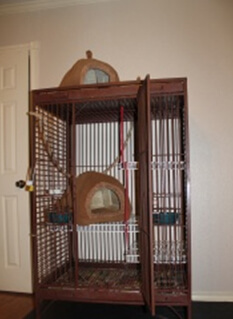 If you want just one (good luck on that as they become addicting). I have never had only one Coati so I don’t talk from experience, but this is a safe option in my opinion. Keep them in a large macaw cage or one of those extra-large Great Dane cages if you are on a budget. The large macaw cages run an average of $400 to $700. This will allow the Coati to climb up and you can install a hammock for them to sleep in. I also recommend installing wire shelves, not wood or anything solid. Shelves will allow your Coati some exercise and any excrement to fall to the bottom of the cage. Make sure to get a cage with a tall wire grate on the bottom. Coatis get bored or try to retrieve fallen food items and will rip the poo papers from the bottom tray ( messy). You can raise the bottom of any cage by zip tying wire shelf racks cut to fit the cage floor.
If you want just one (good luck on that as they become addicting). I have never had only one Coati so I don’t talk from experience, but this is a safe option in my opinion. Keep them in a large macaw cage or one of those extra-large Great Dane cages if you are on a budget. The large macaw cages run an average of $400 to $700. This will allow the Coati to climb up and you can install a hammock for them to sleep in. I also recommend installing wire shelves, not wood or anything solid. Shelves will allow your Coati some exercise and any excrement to fall to the bottom of the cage. Make sure to get a cage with a tall wire grate on the bottom. Coatis get bored or try to retrieve fallen food items and will rip the poo papers from the bottom tray ( messy). You can raise the bottom of any cage by zip tying wire shelf racks cut to fit the cage floor.
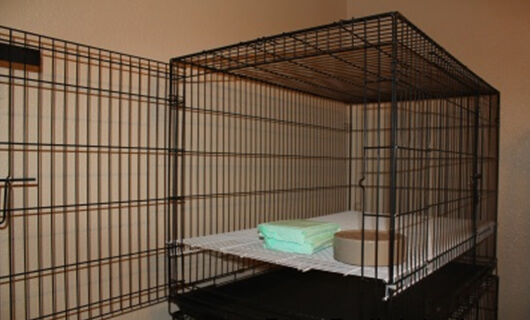
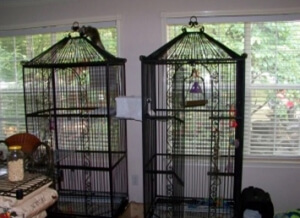 This is how it all began for us! After our little bottle babies grew enough to climb and run. We bought two nice but second-hand matching Macaw cages. My crafty other half made a pass through tunnel and connected the two cages together. This is a wonderful idea for one or two coatis. It really gives them plenty of play room and the best part…..We put a closing shift-door on the tunnel. This allowed us to do a quick clean or feed without letting our little imps out on the loose while we did our clean up. It comes in handy! Trust me, they will try to “help” you with any project you do, so a two minute clean up or feed can end up an hour-long project. Again; install some wire shelves and a few toys and you won’t feel guilty going to work or leaving your babies alone for a few hours.
This is how it all began for us! After our little bottle babies grew enough to climb and run. We bought two nice but second-hand matching Macaw cages. My crafty other half made a pass through tunnel and connected the two cages together. This is a wonderful idea for one or two coatis. It really gives them plenty of play room and the best part…..We put a closing shift-door on the tunnel. This allowed us to do a quick clean or feed without letting our little imps out on the loose while we did our clean up. It comes in handy! Trust me, they will try to “help” you with any project you do, so a two minute clean up or feed can end up an hour-long project. Again; install some wire shelves and a few toys and you won’t feel guilty going to work or leaving your babies alone for a few hours.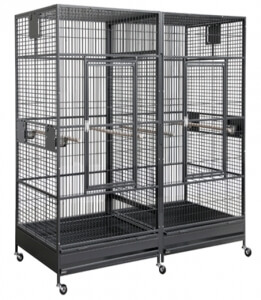 Now that you have become one of us, welcome to the fanatical Coati-owners family! You must say to yourself “I am a Coati addict” and own it… work with it. Don’t let me see you on one of those animal hoarding shows…All jokes aside; you will probably be looking at building custom enclosures. If you are not “Handy Dan” or a welder, let me recommend this cage. I currently own a few of them. It is called the Big Kahuna! It is manufactured by A&E Cage Co.. Many distributors sell them. Price ranges from $800 to $900 depending on who is having a sale. This is a very large cage, made for inside use and you need space. It has a built-in divider wall that is removable and trap doors you can build off of. This cage is too tall and wide to get through most doors assembled. Seriously, assemble it in the room you want it to live in. It has lots of space to install shelves and other toys, and even a swing and hammock.That is wonderful for the Coatis but makes clean-up a little more work. It cost more but, if you can afford it, get the stainless steel version. Up to four Coatis can live comfortable in this with added playtime outside.
Now that you have become one of us, welcome to the fanatical Coati-owners family! You must say to yourself “I am a Coati addict” and own it… work with it. Don’t let me see you on one of those animal hoarding shows…All jokes aside; you will probably be looking at building custom enclosures. If you are not “Handy Dan” or a welder, let me recommend this cage. I currently own a few of them. It is called the Big Kahuna! It is manufactured by A&E Cage Co.. Many distributors sell them. Price ranges from $800 to $900 depending on who is having a sale. This is a very large cage, made for inside use and you need space. It has a built-in divider wall that is removable and trap doors you can build off of. This cage is too tall and wide to get through most doors assembled. Seriously, assemble it in the room you want it to live in. It has lots of space to install shelves and other toys, and even a swing and hammock.That is wonderful for the Coatis but makes clean-up a little more work. It cost more but, if you can afford it, get the stainless steel version. Up to four Coatis can live comfortable in this with added playtime outside.